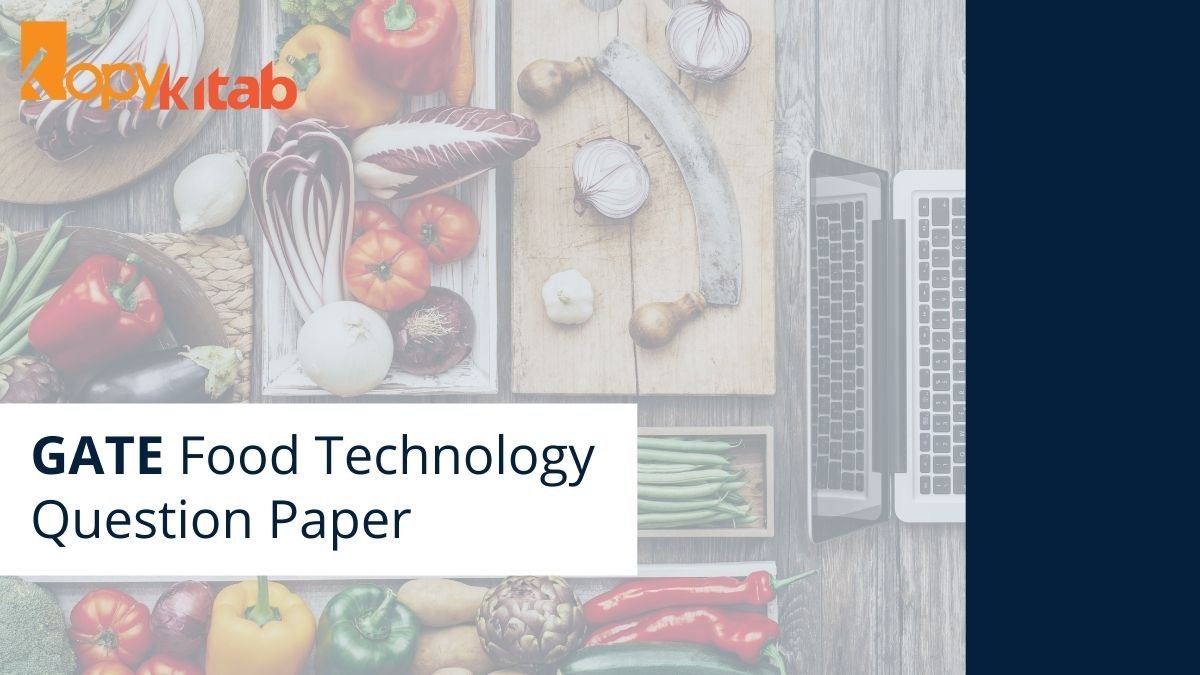
GATE Food Technology Question Paper: Download the GATE Food Technology Question Paper in pdf format. Today we are supplying GATE Question Papers of Food Technology. On this page, you can get GATE Food Technology Question Papers from cutting-edge to beyond a few years. Previous papers are furnished with download desire in pdf format.
Download Free PDF GATE Food Technology Question Paper
| GATE Food Technology Question Paper 2019 |
| GATE Food Technology Question Paper 2020 |
GATE Food Technology Syllabus 2022
Section 1: Food Chemistry and Nutrition
Carbohydrates: structure and functional properties of mono-, oligo-, & poly-
saccharides including starch, cellulose, pectic substances and dietary fibre,
gelatinization and retrogradation of starch. Proteins: classification and structure of
proteins in food, biochemical changes in post mortem and tenderization of
muscles. Lipids: classification and structure of lipids, rancidity, polymerization and
polymorphism. Pigments: carotenoids, chlorophylls, anthocyanins, tannins
and myoglobin. Food flavours: terpenes, esters, aldehydes, ketones and quinines.
Enzymes: specificity, simple and inhibition kinetics, coenzymes, enzymatic and non-
enzymatic browning. Nutrition: balanced diet, essential amino acids and essential
fatty acids, protein efficiency ratio, water soluble and fat soluble vitamins, role of
minerals in nutrition, co-factors, anti-nutrients, nutraceuticals, nutrient deficiency
diseases. Chemical and biochemical changes: changes occur in foods during
different processing.
Section 2: Food Microbiology
Characteristics of microorganisms: morphology of bacteria, yeast, mold and
actinomycetes, spores and vegetative cells, gram-staining. Microbial growth:
growth and death kinetics, serial dilution technique. Food spoilage: spoilage
microorganisms in different food products including milk, fish, meat, egg, cereals
and their products. Toxins from microbes: pathogens and non-pathogens including
Staphylococcus, Salmonella, Shigella, Escherichia, Bacillus, Clostridium, and
Aspergillus genera. Fermented foods and beverages: curd, yoghurt, cheese, pickles,
soya-sauce, sauerkraut, idli, dosa, vinegar, alcoholic beverages and sausage.
Section 3: Food Products Technology
Processing principles: thermal processing, chilling, freezing, dehydration, addition of
preservatives and food additives, irradiation, fermentation, hurdle technology,
intermediate moisture foods. Food packaging and storage: packaging materials,
aseptic packaging, controlled and modified atmosphere storage. Cereal
processing and products: milling of rice, wheat, and maize, parboiling of paddy,
bread, biscuits, extruded products and ready to eat breakfast cereals. Oil
processing: expelling, solvent extraction, refining and hydrogenation. Fruits and
vegetables processing: extraction, clarification, concentration and packaging of
fruit juice, jam, jelly, marmalade, squash, candies, tomato sauce, ketchup, and
puree, potato chips, pickles. Plantation crops processing and products: tea, coffee,
cocoa, spice, extraction of essential oils and oleoresins from spices. Milk and milk
products processing: pasteurization and sterilization, cream, butter, ghee, ice-
cream, cheese and milk powder. Processing of animal products: drying, canning,
and freezing of fish and meat; production of egg powder. Waste utilization: pectin
from fruit wastes, uses of by-products from rice milling. Food standards and quality
maintenance: FPO, PFA, Agmark, ISI, HACCP, food plant sanitation and cleaning in
place (CIP).
Section 4: Food Engineering
Mass and energy balance; Momentum transfer: Flow rate and pressure drop
relationships for Newtonian fluids flowing through pipe, Reynolds number. Heat
transfer: heat transfer by conduction, convection, radiation, heat exchangers. Mass
transfer: molecular diffusion and Fick’s law, conduction and convective mass
transfer, permeability through single and multilayer films. Mechanical operations:
size reduction of solids, high pressure homogenization, filtration, centrifugation,
settling, sieving, mixing & agitation of liquid. Thermal operations: thermal sterilization,
evaporation of liquid foods, hot air drying of solids, spray and freeze-drying, freezing
and crystallization. Mass transfer operations: psychrometry, humidification and
dehumidification operations.
We have included complete information regarding GATE Food Technology Question Paper. If you have any questions feel free to ask in the comment section.
FAQ: GATE Food Technology Question Paper
Can I download GATE Food Technology Question Paper free PDF?
Yes, you can download a free PDF For GATE Food Technology Question Paper.
Why is the GATE exam for?
The purpose of the GATE exam is to test students’ knowledge and understanding of their Graduate level subjects in Engineering and Science.
Which IIT sets the toughest paper for GATE?
IISC Bangalore is known for setting the most difficult GATE papers
Who are eligible for GATE 2022?
A candidate who is currently studying in the 3rd or higher years of any undergraduate degree program OR has already completed any government-approved degree program in Engineering / Technology / Architecture / Science / Commerce / Arts is eligible for appearing in the GATE 2022 exam.
